Material
EMI Gasket Materials
Highly specialized metal-filled silicones made to protect sensitive hardware from electromagnetic interference (EMI)
Highly specialized metal-filled silicones made to protect sensitive hardware from electromagnetic interference (EMI)

In addition to managing EMI emissions and susceptibility, Stockwell Elastomerics’ conductive gaskets are used for environmental sealing. With proper compression, these gaskets can seal out rain (NEMA 3), withstand pressure washing (IP65, IP66, NEMA 4X) and prohibit water ingress during submersion (IP67, NEMA 6).
EMI shielding materials are an extension of Stockwell Elastomerics’ silicone rubber capabilities – EMI gaskets can be die cut, waterjet cut or compression molded from electrically conductive silicone rubber compounds with age and weather resistance or conductive fluorosilicone rubber for additional chemical resistance.
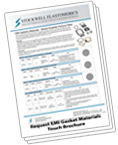
Includes small samples of EMI gasket materials to touch and feel.
Nickel-graphite filled compounds have been developed with high shielding effectiveness values (over 100dB from 100MHz to 1GHz) at a cost far less than silver filled compounds. Further, nickel-graphite filled silicones withstand harsh environmental conditions including salt fog/spray, UV and ozone.
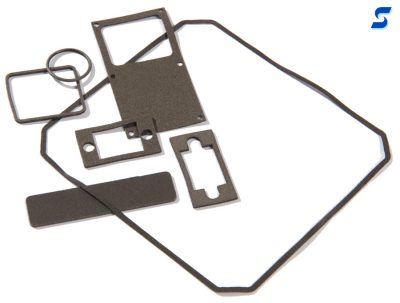 Commercial Applications
Commercial ApplicationsNickel-graphite filled silicone gaskets are widely used for commercial applications where the higher cost of silver or copper filled materials is prohibitive. Industries such as lighting, signage, and instrumentation that historically haven’t required EMI attenuation, now do as a result of integrated electronics for “smart” features and tighter regulations. With more innovation and mobile devices, EMI emissions will need to be addressed by designers of OEM equipment – and often at the end of the design cycle. Stockwell Elastomerics offers nickel-graphite filled silicones, readily available from inventory, in sheet form with thicknesses: .020″, .032″, .045″, .062″, .093″, and .125″ to support prototyping and fast-turn gasket production. Customers can send a CAD file, .stp or .dxf of the gasket design so Stockwell Elastomerics can determine the best choice of material and provide a waterjet cut gasket for testing.
Designers in defense and aerospace related applications are now specifying nickel-graphite filled silicone gaskets for custom molded gaskets, O-rings and fabricated gaskets, thereby reducing costs of applications where silver filled or silver plated particle filled compounds were previously specified. These compounds have been specified for applications ranging from seals for power supply gaskets to enclosure gaskets. The SNE-540, 40 durometer and SNE-556, 65 durometer nickel-graphite filled silicone compounds in particular have been subjected to extensive testing by several independent testing facilities. Along with shielding effectiveness values (see chart below), independent testing determined the thermal conductivity of SNE-556 to be 0.8 W/m-K and Low Temperature Flex, TR10 to pass at -40°C.
Stockwell Elastomerics inventories uncured nickel-graphite filled silicone compound as well as cured sheets from .020″ to 0.125″ thicknesses. If sheets are not immediately available, Stockwell Elastomerics’ on-site Molding operations can quickly produce sheets to support requirements for die cut and fabricated gaskets. The standard sheet size is 15″ x 20″.
 Continuous Roll EMI Gasket Material
Continuous Roll EMI Gasket MaterialIf 15″ x 20″ standard sheets are not suitable due to large gasket dimensions, continuous roll material SNE-540-C is available in .010″, .020″ thick and .032″ thick rolls up to 15″ wide, custom thicknesses are available upon request. Continuous format offers designers the ability to design EMI shielding gaskets for larger enclosures with fewer splices. Stockwell Elastomerics has on-site water jet cutting for precise corner jointed gaskets and tightly fitting splices for environmental and shielding integrity.
Stockwell Elastomerics offers 3M 9713 conductive acrylic adhesive or 3M 9719 conductive silicone adhesives. Electrically conductive adhesives are laminated to EMI / RFI materials for ease of installation. Request a sample swatch of SNE-5XX series EMI gasket materials via the contact form.
SNE-540-R and SNE-556-R are 40 and 65 durometer (Shore “A”), respectively, with low volume resistivity that challenges silver coated aluminum filled silicones. SNE-540-R and SNE-556-R have conductive fabric reinforcement that enhances the conductivity and tensile strength while maintaining Z-axis compression for EMI and environmental sealing.
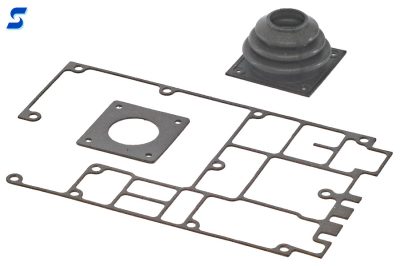 It is typical for particle filled silicone rubber materials to have lower strength as a result of heavy loading of conductive filler. This lower strength is often problematic for gaskets with thin walls that are susceptible to breaking from over stretching. The fabric reinforcement in the SNE-540-R and SNE-556-R materials addresses these issues.
It is typical for particle filled silicone rubber materials to have lower strength as a result of heavy loading of conductive filler. This lower strength is often problematic for gaskets with thin walls that are susceptible to breaking from over stretching. The fabric reinforcement in the SNE-540-R and SNE-556-R materials addresses these issues.
SNE-540-R and SNE-556-R fabric reinforced EMI silicones are manufactured in continuous rolls that are 12″ and 15″ wide. Continuous EMI gasket material enables large EMI gaskets to be made in one piece. Standard thicknesses are .020″ and .032″; custom thicknesses are also available.
Stockwell Elastomerics offers 3M 9713 conductive acrylic adhesive or 3M 9719 electrically conductive silicone adhesives that can be laminated to these reinforced EMI gasket materials for ease of installation.
More complex designs, extending beyond flat cut shapes, are custom molded by Stockwell Elastomerics on-site in the United States. Compression molds are used to produce custom EMI gaskets and custom conductive parts. Three dimensional designs allow for tighter tolerances and the use of shape factors to reduce the closure force on the filled conductive polymers.
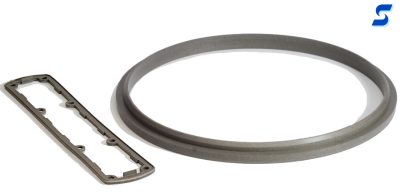 In the right quantities, molding custom EMI gaskets offers engineers significant unit cost savings over die cutting. EMI / RFI gasket materials tend to be higher in cost compared to unfilled silicone compounds; this is especially true for silver filled EMI compounds. The material savings associated with molding very often offsets the higher tooling cost of a custom mold. Generally, if the production quantities are expected to exceed 1000 pieces, the initial tooling investment in a compression mold will pay off with a reduced unit cost.
In the right quantities, molding custom EMI gaskets offers engineers significant unit cost savings over die cutting. EMI / RFI gasket materials tend to be higher in cost compared to unfilled silicone compounds; this is especially true for silver filled EMI compounds. The material savings associated with molding very often offsets the higher tooling cost of a custom mold. Generally, if the production quantities are expected to exceed 1000 pieces, the initial tooling investment in a compression mold will pay off with a reduced unit cost.
Stockwell Elastomerics inventories nickel-graphite EMI sheet material made from the same compounds used to mold custom EMI components. Stockwell Elastomerics can waterjet cut low volume EMI / RFI gaskets to prove out engineering designs, then these designs can be easily tooled up for molding when parts move into pre-production and production phases.
Stockwell Elastomerics is based in Philadelphia, PA and all gaskets and components are manufactured at this single location. Stockwell Elastomerics is an ITAR registered manufacturer, Cage Code 87585. Additionally, all electrically conductive molding compounds and molds used by Stockwell Elastomerics are manufactured in the United States and certified with supporting test data. Stockwell Elastomerics is committed to supporting medical, defense and other sensitive industries that require the highest quality and material lot traceability.
Stockwell Elastomerics has partnered with Specialty Silicone Products (SSP) to develop product offerings in nickel-graphite filled silicone and fluorosilicone compounds, supplied with physical test reports to ensure properties are consistently met.
Nickel Graphite Filled Materials Available Molded and Fabricated for EMI Shielding Gaskets
| Material | Duro “A” | Tensile Strength (PSI) | Elongation at Break (%) | Tear Strength PPI of Width | Volume Res. (Ohm‑cm) | Comments, Additional Info |
|---|---|---|---|---|---|---|
| SNE‑553 | 30 | 100 | 300 | 25 | 0.75 | – Soft EMI gasket material, available with conductive adhesive backing |
| SNE‑540 | 40 | 150 | 200 | 25 | 0.05 | – Widely used for commercial EMI gasket applications – Replaces Rogers EC-2040 – Tested Shielding Effectiveness* |
| SNE‑555 | 55 | 250 | 300 | 30 | 0.05 | – Used for commercial EMI gasket applications |
| SNE‑556 | 65 | 250 | 300 | 45 | 0.03 | – Used for commercial and defense applications – Tested Shielding Effectiveness* |
| SNEF‑60 | 65 | 200 | 200 | 45 | 0.03 | – Fluorosilicone Base for Fluid Resistance |
| Options for each material: Sheets, Cut Parts, Molded Parts | ||||||
| * SNE-540 and SNE-556 tested for Shielding Effectiveness by DLS Testing Laboratories. |
Nickel Graphite Filled Materials Test Results
| Material | Test Frequency | Shielding Effectiveness Effectiveness | Test Method | Comments, Additional Info |
|---|---|---|---|---|
| SNE-540 & SNE-556 | 100 MHz (E field) | 125.2 | MIL?DTL?83528D | Third party tested ? DLS |
| SNE-540 & SNE-556 | 400 MHz (E field) | 126.3 | MIL?DTL?83528D | Third party tested ? DLS |
| SNE-540 & SNE-556 | 600 MHz (E field) | 126.1 | MIL?DTL?83528D | Third party tested ? DLS |
| SNE-540 & SNE-556 | 2 GHz (Plane Wave) | 115.7 | MIL?DTL?83528D | Third party tested ? DLS |
| SNE-540 & SNE-556 | 10 GHz (Plane Wave) | 115.5 | MIL?DTL?83528D | Third party tested ? DLS |
| SNE-540 & SNE-556 | 40 GHz (Plane Wave) | 76.3 | MIL?DTL?83528D | Third party tested ? DLS |
 Rogers Corporation’s EC-2130 nickel-graphite filled silicone rubber is a compressible 30 durometer electrically conductive gasketing material. EC-2130 is the only nickel-graphite filled gasketing material available in 36″ wide continuous rolls making it ideal for large EMI gaskets. Available in .062″ and .125″ thickness, EC-2130 is UL 94HB flame rated. Application of 3M #9713 conductive fabric supported acrylic adhesive provides both a conductive adhesive surface for EMI shielding integrity and dimensional stability to reduce tears during handling and assembly of this very conformable material.
Rogers Corporation’s EC-2130 nickel-graphite filled silicone rubber is a compressible 30 durometer electrically conductive gasketing material. EC-2130 is the only nickel-graphite filled gasketing material available in 36″ wide continuous rolls making it ideal for large EMI gaskets. Available in .062″ and .125″ thickness, EC-2130 is UL 94HB flame rated. Application of 3M #9713 conductive fabric supported acrylic adhesive provides both a conductive adhesive surface for EMI shielding integrity and dimensional stability to reduce tears during handling and assembly of this very conformable material.
Note that Rogers EC-2040, 40 durometer nickel-graphite filled silicone was recently discontinued. However, SNE-540, 40 durometer nickel-graphite filled silicone is now produced in continuous rolls .020″ thick x 15″ wide and .032″ thick x 15″ wide to replace EC-2040 in Stockwell Elastomerics’ product line.
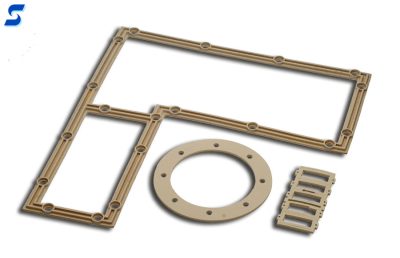 Military electronics such as communication equipment and radar equipment requiring maximum shielding effectiveness from high frequencies often require silver or silver plated particle filled compounds. Stockwell Elastomerics has teamed up with Specialty Silicone Products (SSP) to specify compounds with silver plated aluminum fillers having a tight particle size distribution. This provides consistently low volume resistivity and a smooth surface condition that contributes to Stockwell Elastomerics’ ability to compression mold these compounds into custom gaskets.
Military electronics such as communication equipment and radar equipment requiring maximum shielding effectiveness from high frequencies often require silver or silver plated particle filled compounds. Stockwell Elastomerics has teamed up with Specialty Silicone Products (SSP) to specify compounds with silver plated aluminum fillers having a tight particle size distribution. This provides consistently low volume resistivity and a smooth surface condition that contributes to Stockwell Elastomerics’ ability to compression mold these compounds into custom gaskets.
Each of the silver plated aluminum filled compounds listed below are available in sheets that are .010″, .020″, .032″, .040″, .050″ and .062″ thick for gasket fabrication. On-shelf inventory in .020″ and .032″ thicknesses is frequently available to support fast-turn initial production requirements and limited material sampling for evaluation.
Compounds for Stockwell Elastomerics’ silver plated aluminum filled silicones and fluorosilicones are supplied with physical test reports to ensure properties are consistently met.
Silver Plated Aluminum Filled Materials Available Molded and Fabricated for EMI Shielding Gaskets
| Material | Duro “A” | Tensile Strength (PSI) | Elongation at Break (%) | Tear Strength PPI of Width | Volume Res. Volume Res. (Ohm‑cm) | Comments, Volume Res. (Ohm‑cm) |
|---|---|---|---|---|---|---|
| SCF‑444* | 45 | 150 | 300 | 20 | 0.004 | Soft EMI / environmental gasket with low volume resistance |
| SSE‑586 | 65 | 150 | 100 | 30 | 0.008 | MIL-DTL-83528, Type B |
| SCF‑447* | 70 | 180 | 150 | 35 | 0.008 | MIL-DTL-83528, Type D |
| Options for each material: Sheets, Cut Parts, Molded Parts | ||||||
| * SCF-444 and SCF-447 are fluorosilicone base compounds for fluid, fuel and oil resistance. |
The main advantage of EMI shielding gaskets fabricated from conductive elastomers is the combined benefit of environmental sealing over a broad temperature range along with EMI shielding. This EMI gasket material is typically silicone rubber or fluorosilicone rubber with embedded silver plated aluminum particles, silver plated glass beads, silver plated copper particles, nickel-graphite particles or conductive carbon. Many of these EMI shielding materials meet the properties of MIL-DTL-83528. Conductive silicone rubber materials are typically molded into sheets from .010″ to .125″ thick and 12″ x 12″ to 10″ x 15″ in size and then die cut or water jet cut to the final gasket configuration.
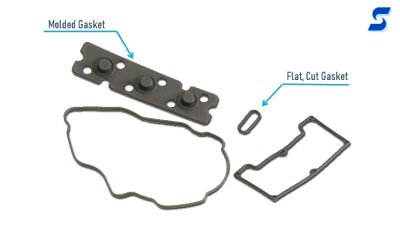 Stockwell Elastomerics has partnered with Specialty Silicone Products (SSP) to develop products well suited for EMI gaskets that have long term use in harsh environments. These electrically conductive gasket materials are nickel-coated aluminum particle filled (aka nickel-aluminum), in silicone and fluorosilicone compounds. They are available in sheets, cut gaskets and compression molded gaskets for EMI shielding applications requiring galvanic corrosion resistance and long term shielding performance.
Stockwell Elastomerics has partnered with Specialty Silicone Products (SSP) to develop products well suited for EMI gaskets that have long term use in harsh environments. These electrically conductive gasket materials are nickel-coated aluminum particle filled (aka nickel-aluminum), in silicone and fluorosilicone compounds. They are available in sheets, cut gaskets and compression molded gaskets for EMI shielding applications requiring galvanic corrosion resistance and long term shielding performance.
Specific applications include electrical housings installed in marine environments and similar environments where galvanic corrosion/coupling may be a risk.
Two nickel-coated, aluminum particle filled compounds are available:
Both materials are dark gray and have a smooth surface. Materials come with extensive 3rd party testing and vendor certificates of analysis. Salt spray, compression force deflection (to ASTM D575), shielding test reports (to MIL-DTL-83528F), outgassing testing (to ASTM E595 and NASA/industry standards) are available upon request.
These materials can be more cost effective and price stable than silver-filled elastomers due to the volatility in silver prices.
Die cut gaskets or waterjet cut gaskets fabricated from SNA-568 and SNAF-572 are available from .020” thick to .125” thickness, and compression molded gaskets are available custom molded from uncured compound if sealing beads or similar design features are required. Fabricated gaskets may be provided with an electrically conductive acrylic or conductive silicone pressure sensitive adhesive to serve as an assembly aid.
Nickel-Coated Aluminum Filled Compounds – Electrically Conductive Galvanic Corrosion Resistant Elastomer – EMI/ESD
| Material Name | Description | Duro “A” | Vol. Resist. (Ohm-cm) | Common Applications |
|---|---|---|---|---|
| SNA-568 | Conductive Silicone, Nickel-Coated Aluminum Filler | 68 | 0.08 | EMI Gaskets, Superior Galvanic Protection |
| SNAF-572 | Conductive Fluorosilicone, Nickel-Coated Aluminum Filler | 72 | 0.03 | EMI Gaskets, Superior Galvanic Protection, Additional Fuel Resistance |
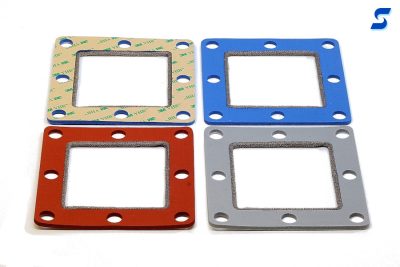 Enclosures requiring environmental gaskets that seal out dust and rain sometimes also require EMI / RFI shielding. Industries such as telecommunications, military and smart grid require long term sealing as well as EMI attenuation; often these larger enclosures have low closure forces due to sheet metal construction or limited latches. Stockwell Elastomerics offers combination gaskets made from closed cell silicone sponge or silicone foam with knitted wire mesh cord bonded to the edge of the gasket. The soft sponge and wire mesh construction allow for thicker gaskets that can be compressed with less closure force as compared to particle filled silicone gaskets. Large enclosures and server racks benefit from Stockwell Elastomerics’ combination EMI gaskets since the thicker material (0.125″ – 0.375″) allows for more gap filling created by tolerance stack ups in large parts.
Enclosures requiring environmental gaskets that seal out dust and rain sometimes also require EMI / RFI shielding. Industries such as telecommunications, military and smart grid require long term sealing as well as EMI attenuation; often these larger enclosures have low closure forces due to sheet metal construction or limited latches. Stockwell Elastomerics offers combination gaskets made from closed cell silicone sponge or silicone foam with knitted wire mesh cord bonded to the edge of the gasket. The soft sponge and wire mesh construction allow for thicker gaskets that can be compressed with less closure force as compared to particle filled silicone gaskets. Large enclosures and server racks benefit from Stockwell Elastomerics’ combination EMI gaskets since the thicker material (0.125″ – 0.375″) allows for more gap filling created by tolerance stack ups in large parts.
Compared to metal filled EMI gaskets, Stockwell Elastomerics’ combination sponge / wire mesh gaskets are very soft. Softer means less compression force needed to properly compress the gasket for a seal. Filled silicone EMI gaskets may require 150 – 300psi to deflect the gasket 33% whereas the sponge/mesh takes 15 – 50psi (depending on the sponge used).
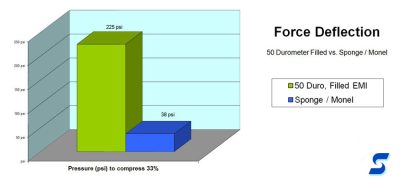 Custom EMI Gaskets – Sponge / Mesh Cord
Custom EMI Gaskets – Sponge / Mesh CordStockwell Elastomerics is a leading supplier of custom silicone gaskets and silicone components for commercial, industrial and defense applications. For this reason, a full inventory of silicone sponge products is maintained that can be combined with Monel wire mesh cord to make a combination EMI gasket. These EMI gaskets are cut to customer specifications and drawings.
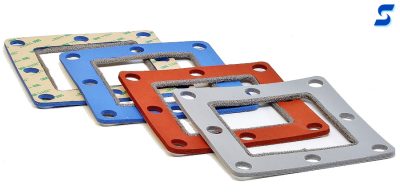 Corner Bonded Gasket – Sponge / Mesh Cord
Corner Bonded Gasket – Sponge / Mesh CordServer rack gaskets and large NEMA enclosure gaskets can generate significant waste if cut from a single piece of silicone sponge. To help reduce waste and associated costs, Stockwell Elastomerics offers corner bonded gaskets. Dovetail and other interlocking joints are cut into the four legs of the gasket and bonded in a secondary process. Corner bonded gaskets are available with or without the Monel wire mesh cord used for EMI gaskets.
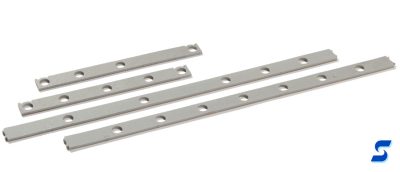 Fluorosilicone Sponge Combination EMI Gasket
Fluorosilicone Sponge Combination EMI GasketParticular applications require a higher level of chemical resistance for exposure to fuels or cleaning agents. Stockwell Elastomerics offers combination EMI gaskets made from closed cell fluorosilicone sponge and knitted monel wire mesh.
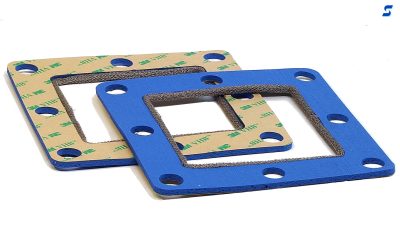 UL Silicone Sponge for EMI Combination Gaskets
UL Silicone Sponge for EMI Combination GasketsUL 50E silicone foam and silicone sponge are available to make EMI combination gaskets. While the final configuration of wire mesh and sponge has not been qualified by UL, the silicone foam and silicone sponge have been tested to UL 50E gasket standards. In addition, the silicone foam also meets UL 94V-0 flame rating.
Electromagnetic interference (EMI) is a disturbance that interrupts, obstructs, degrades, or otherwise limits the effective performance of electronics and electrical equipment. The “electromagnetic” in EMI refers to how electric current has electrical and magnetic forces and effects. The “interference” in EMI refers to how when an electromagnetic signal is transmitted, or propagated, that signal can be received by a circuit that is not the intended recipient.
EMI is associated with but not identical to radio frequency interference (RFI), an electromagnetic disturbance that affects radio frequency (RF) communications. The RF portion of the electromagnetic spectrum includes radio waves and microwaves, so RFI isn’t limited to RF devices. Typically, however, RFI refers to lower-frequency interference from an external source while EMI refers to higher-frequency interference from the device itself. EMI and RFI affect devices differently, but they both affect electromagnetic compatibility (EMC), the ability of different devices to operate without mutual interference.
EMI shielding protects the circuits in electronic devices and electrical equipment from conducted, radiated, human-made and naturally-occurring electromagnetic interference. There are different types of EMI shielding, but most either consist of or contain metal, because metal is electrically conductive and supports the free flow of electrons. When there is electronic “noise”, the EMI shielding prevents these signals and the resulting electrical current is sent to ground. By preventing harmful signals from entering or escaping, communications also remain cleaner.
EMI shielding is used in industries ranging from consumer electronics, telecommunications, and information technology (IT) to automotive, aerospace, defense, space, and medical device manufacturing. Some EMI shielding materials, such as specialized adhesives, are applied to printed circuits boards (PCBs). Others are applied as coatings or paints to enclosures and cables. EMI shielding can be used between noisy components within a device, or to seal the entire enclosure. Regardless of the enclosure material, however, EMI gasketing is used to fill the gaps between mating surfaces such as lids and panels.
Electrically conductive elastomers, silicone and fluorosilicone in particular, provide specific levels of EMI shielding and can be fabricated into gaskets and other types of products, such as EMI O-rings. Like plastic, silicone is normally an electrical insulator; however, the addition of metal or metal-coated particles makes it electrically conductive. As the base elastomer, silicone and fluorosilicone provide high elasticity, high compressibility, strong environmental resistance, and broad temperature resistance. Silicone isn’t the only material that can be used in EMI shielding, but its material properties make it an attractive option for high performance and demanding environments.
This video offers a simple visual demonstration of the conductivity of various EMI shielding gasket materials. The tan material in the video has silver coated aluminum particles, the dark grey material is nickel coated graphite. The last example shows a 3M conductive adhesive where the conductive path flows through the metal plate, up through the adhesive, through the conductive material into the LED.
 Request a Free Silicone EMI Gasket Materials Touch Brochure
Request a Free Silicone EMI Gasket Materials Touch BrochureIncludes small samples of EMI gasket materials to touch and feel.
Contact Us for further assistance with EMI shielding materials, conductive elastomers, and electrically conductive silicone materials to manufacture EMI gaskets.